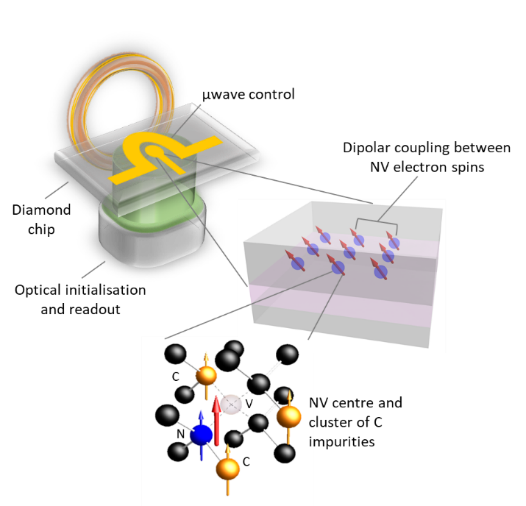Fraunhofer IAF welcomes start-up Quantum Brilliance to Freiburg
Scalable diamond-based quantum microprocessors under development
Providing the conditions for scalable diamond quantum microprocessors and thus advancing the economic usability of quantum computing in Germany—this is what the joint project “Deutsche Brilliance” has been working on since December 1, 2021. The BMBF is funding the cooperation between Fraunhofer IAF, the start-up Quantum Brilliance and Ulm University for three years with 15.6 million euros through the “Enabling Start-up” measure. For the best possible exchange between the project partners, a team of Quantum Brilliance is located at Fraunhofer IAF.
The joint project “Deutsche Brilliance” (DE-Brill) aims to harness the special material properties of diamond and develop technologies for manufacturing and controlling diamond-based quantum microprocessors (“quantum processing units”, QPUs) by 2025. The project team consists of the Australian-German start-up Quantum Brilliance, the Freiburg-based Fraunhofer Institute for Applied Solid State Physics IAF and the Institute of Quantum Optics at Ulm University.
QPUs are intended to provide quantum advantages for applications such as edge computing—a basic technological prerequisite for the complex infrastructure of the Internet of Things (“IoT”), which in perspective can enable autonomous mobility and digitized industrial production. The German Federal Ministry of Education and Research (BMBF) is supporting the project for three years with 15.6 million euros through the funding measure “Enabling Start-up—Start-ups in Quantum Technologies and Photonics”. The total project volume is 19.9 million euros.

Advantages and limitations of diamond-based quantum computers
A central challenge in the development of quantum computers is the technological realization of quantum bits (qubits). Various approaches exist for the creation of qubits. They can, for example, be created based on nuclear spins in solids. In this regard, a still young approach is the use of diamond as a host material. Diamond-based quantum computers promise significant advantages in practical applications: they can be built and operated more energy-efficiently, reliably and compactly than quantum processors based on superconducting qubits. There is no need for cooling them to cryogenic temperatures and evacuating them in complex systems. In fact, diamond qubits operate at room temperature and ordinary pressure ratios due to the extremely stable diamond crystal lattice.
Diamond qubits are created through the quantum entanglement of quasi-free electrons in nitrogen-vacancy centers (“NV centers”) of the diamond crystal lattice. However, current methods for the fabrication of such NV centers do not allow an upscaling of diamond-based qubits to sufficiently large assemblies of multiple qubits in the form of arrays, which are needed for quantum computing. So far, there is a lack of methods that allow a defined placement of nitrogen atoms in the crystal lattice. This, however, is necessary for the coupling of multiple NV centers to create larger arrays.
Manufacturing process for the base material of scalable diamond quantum computers
In the course of its subproposal within the joint project, Fraunhofer IAF is developing growth processes for diamond substrates of the highest purity and quality. In close collaboration with Quantum Brilliance, it is also designing precision manufacturing techniques for the production of scalable arrays of diamond qubits. Researchers of Fraunhofer IAF aim to achieve the necessary local accuracy in the placement of nitrogen atoms of less than one nanometer using scanning probe microscopy.
“This approach for the targeted placement of NV centers is so far unique and a crucial step towards scaling NV arrays for quantum computing applications,” explains Dr. Ralf Ostendorf, project leader on the side of Fraunhofer IAF. For this reason, the joint project “DE-Brill” will also contribute to the further development of the technology with regard to future research projects as well as industrial applications in the fields of sensor technology, imaging or communication.
Parallel to the Fraunhofer IAF subproject, a team led by Prof. Dr. Fedor Jelezko at the Institute for Quantum Optics of Ulm University is working on defining scalable readout and control techniques for diamond-based qubits, which will allow their precise operation.
Quantum Brilliance at the site of Fraunhofer IAF
Fraunhofer IAF and Quantum Brilliance are working closely together within the framework of “DE-Brill”. In order to make the best possible use of the facility infrastructure at the Freiburg site and to ensure short exchange cycles, Fraunhofer IAF has welcomed a team from Quantum Brilliance to exclusively use the institute’s own premises for this purpose.
The joint location allows the partners to react quickly to measurement and characterization results, to directly improve ongoing experimental processes and to maintain a continuous exchange of knowledge. “The fact that we can work together on site at Fraunhofer IAF enables us to achieve an unprecedented mutual transfer of know-how, from which the project benefits greatly,” emphasizes Dr. Mark Mattingley-Scott, General Manager of Quantum Brilliance, who is responsible for the European economic region.
The project “Deutsche Brilliance” (DE-Brill) is funded by the German Federal Ministry of Education and Research (BMBF).
The use of the photos is permitted exclusively in connection with this press release and with indication of the copyright.
Last modified:
 Fraunhofer Institute for Applied Solid State Physics IAF
Fraunhofer Institute for Applied Solid State Physics IAF